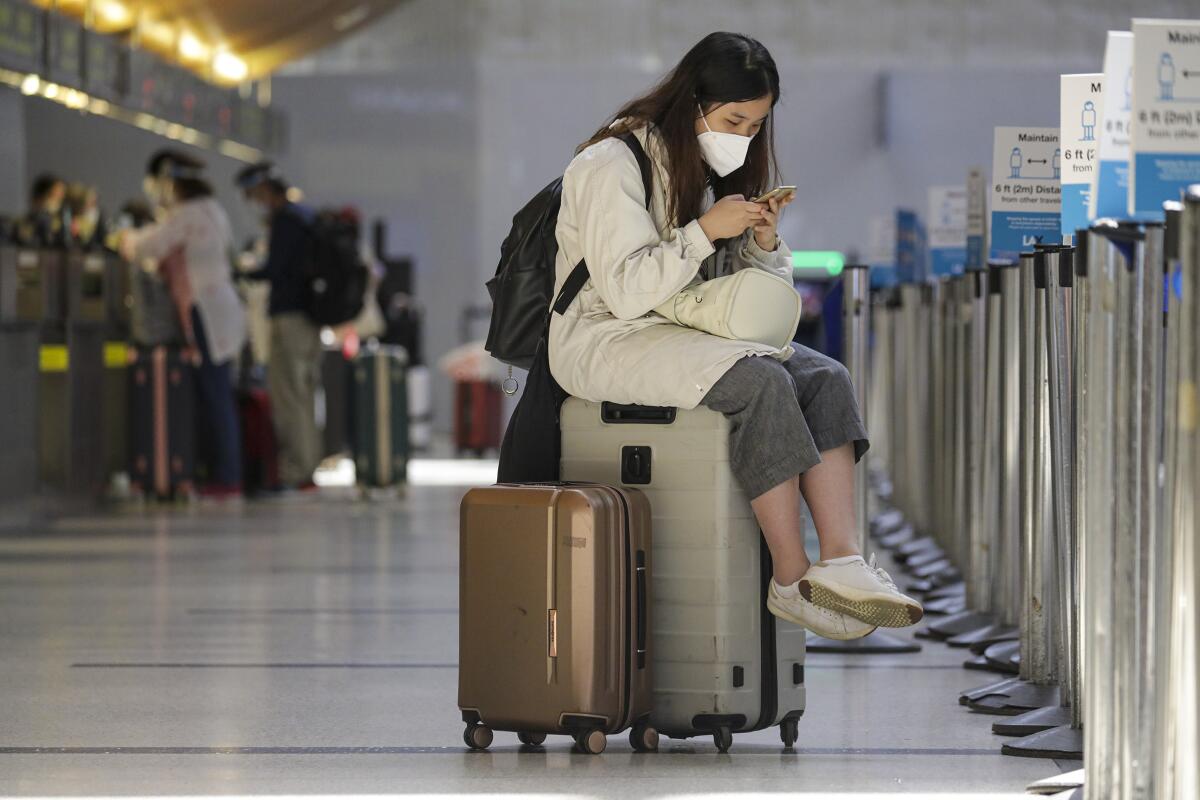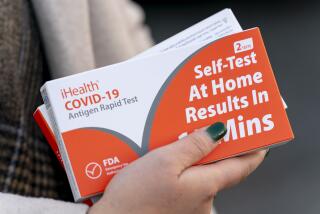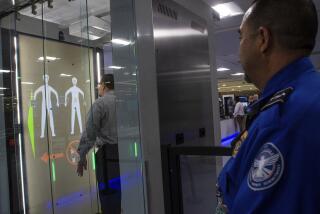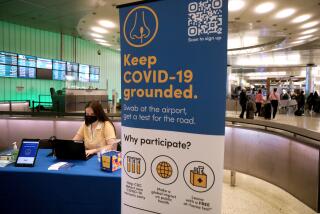Airlines look to help ailing industry with coronavirus testing at airports (but it’s not a cure-all)

- Share via
Financially strapped airlines are pushing an idea intended to breathe new life into the travel industry: coronavirus tests that passengers can take before boarding a flight.
Several airlines, including United, American, Hawaiian, JetBlue and Alaska, have announced plans to begin offering testing — either kits mailed to a passenger’s home or rapid tests taken at or near airports — that would allow travelers to enter specific states and countries without having to quarantine.
The tests will cost fliers $90 to $250, depending on the airline and the type of test.
At Los Angeles International Airport, a design company has announced plans to convert cargo containers into a coronavirus testing facility with an on-site lab that can produce results in about two hours. On Thursday, Tampa International Airport began offering testing to all arriving and departing passengers on a walk-in basis.
It’s an idea that has gone global, with a trade group for the world’s airlines calling on governments to create a testing standard for airline passengers as a way to fight the COVID-19 pandemic instead of using travel restrictions and mandatory quarantines.
“Testing all passengers will give people back their freedom to travel with confidence,” Alexandre de Juniac, director general and chief executive of the International Air Transport Assn., said in a statement. “And that will put millions of people back to work.”
Although the idea is primarily designed to help passengers avoid quarantine requirements at their destinations, health experts say testing passengers immediately before a flight would also lower the odds that an infected person will board a plane and pass the virus to others.
But, the experts emphasize, testing won’t make flying free of health risks.
For one, coronavirus tests aren’t 100% accurate. Additionally, people who are tested a few days in advance have time to catch the virus before flying. And, of course, optional testing can’t detect the virus in travelers who choose not to be tested.
“If it’s an accurate test, a good one, it will help,” said Dr. Timothy Brewer, a professor in the division of infectious diseases at UCLA’s David Geffen School of Medicine. “It won’t eliminate the risk, but it will reduce it.”
Experts fear that if testing expands, there may not be enough rapid tests available for all passengers who request it, and that if enough tests are produced, the process could take hours rather than minutes, creating added gridlock at airports.
“There are a lot of logistics that would have to be worked out,” said Dr. James Zehnder, director of clinical pathology at Stanford University Medical Center.
Despite the obstacles, the airline industry is describing rapid preflight testing as one of the best ways to revive a slumping travel industry, short of distributing a COVID-19 vaccine to all Americans.
“We view this as an important step in our work to accelerate an eventual recovery of demand,” Robert Isom, president of American Airlines, said in a statement Tuesday.
Although the number of Americans flying on commercial airlines has increased slightly in the last few weeks, overall travel demand is down about 70% compared with pre-pandemic numbers.
Several of the nation’s largest airlines have been pleading for financial relief from the federal government to avert massive layoffs. The nation’s air carriers have already shed about 45,000 full-time positions, mostly via buyouts and early retirement, according to an industry trade group. On Thursday, United and American furloughed more than 32,000 workers combined. And five regional carriers, including Compass Airlines and Trans State Airlines, have ceased operations because of the effects of the pandemic.
Travelers seem to like the idea of testing passengers to reduce the virus risk on flights. A survey by IATA of 4,700 travelers in 11 countries, including the U.S., found that 84% supported testing all travelers.
United, American, Alaska and Hawaiian Airlines plan to offer coronavirus tests in select airports for passengers traveling to Hawaii. The Aloha State requires all visitors to either quarantine for 14 days upon arrival or show a negative result from a recent coronavirus test.
On Oct. 15, United will begin offering Hawaii-bound fliers the option of taking a test at San Francisco International Airport, with results available in about 15 minutes. Passengers can also order a test to be mailed to their home so they can collect their own sample within 72 hours of their flight and mail it to a laboratory that will send the results via text or email within 48 hours. United plans to charge $250 for the rapid test and $80 for the mail-in test.
Hawaiian Airlines will also begin Oct. 15 to offer passengers flying to Hawaii access to drive-through coronavirus testing near the San Francisco airport and LAX, charging $150 for the day-of-travel express service and $90 for results within 36 hours.
American Airlines announced this week that it will also offer preflight testing for passengers flying to Hawaii as well as tests for fliers heading to Jamaica and the Bahamas, with additional markets to be added in the coming weeks and months.
For passengers flying to Hawaii, American will offer either at-home tests or tests that can be taken at Dallas-Fort Worth International Airport or at an urgent care facility near the airport. At Miami International Airport, the airline will offer tests to fliers bound for Jamaica and the Bahamas — island nations whose quarantine requirements are similar to Hawaii’s.
Also this week, JetBlue announced plans to offer at-home coronavirus tests for passengers flying to destinations that call for a negative test result. The samples from the at-home saliva test will be shipped overnight to a laboratory that will produce results in 72 hours or less.
Alaska Airlines said it will direct its passengers to take the coronavirus tests at pop-up clinics throughout the West Coast, starting Oct. 12 in Seattle.
SG Blocks, a designer that specializes in converting cargo containers for other uses, and Grimshaw Architects announced plans to build a modular coronavirus testing center at LAX by Nov. 1. The testing facility is slated to house a laboratory operated under a partnership with SG Blocks and New Jersey-based Clarity Labs.
Coronavirus tests that are currently available fall into one of two categories: a molecular test, which looks for genetic material from the virus and must be analyzed in a lab, with results in a day or two, and an antigen test, which detects certain proteins in the virus and offers results in minutes. The antigen test can be administered at home like a pregnancy test.
The rate at which the tests fail to detect the virus in a person who actually is infected — known as the false negative rate — is as low as 2% and as high as 37% for the molecular test, according to a Harvard Medical School blog post. The false negative rate for the antigen test can be as high as 50%.
The rate of false negative results can be influenced by how soon a test it taken after a person is infected. Studies by Johns Hopkins University researchers found that the false negative rate is much higher when a coronavirus test is taken within a few days of being infected, when virus levels are still low.
Zehnder, of the Stanford University Medical Center, said testing passengers with either test comes with disadvantages: The molecular test is more accurate but requires a laboratory and health experts to perform, while the antigen test is quicker but less accurate.
“There are trade-offs,” he said.
He said he looks forward to the day when the coronavirus will be detected at airports more quickly and accurately, perhaps with a device that relies on mass spectrometry to detect the virus from a quick swab taken from a passenger, similar to the way airport security agents detect explosive residue on a passenger’s luggage.
The airlines that are offering the coronavirus tests say they have no concern about a limit on testing supplies and agree that the tests’ accuracy does vary. But representatives for the carriers say they are still hopeful the tests will help bring back demand for air travel.
After adding the testing, Hawaiian Airlines resumed several previously canceled nonstop flights to Hawaii and increased the frequencies of other flights to coincide with the launch of the testing program.
“We believe offering our guests from the U.S. mainland convenient and accessible testing options will help to bolster the existing demand we’re seeing,” Hawaiian spokeswoman Tara Shimooka said.
Even if everybody on the plane is tested, health experts say they would still recommend that passengers continue to wear masks and maintain physical distancing as much as possible.
“All the other things, you still need to do, even if they were going to test me and everyone else,” Brewer said.
More to Read
Inside the business of entertainment
The Wide Shot brings you news, analysis and insights on everything from streaming wars to production — and what it all means for the future.
You may occasionally receive promotional content from the Los Angeles Times.











